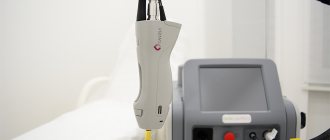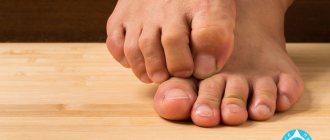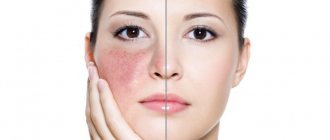After shaving or waxing, many of us face such a problem as ingrown hairs. Not only women, but also men are susceptible to this problem. You are faced with the question: “how to get rid of an ingrown hair?”, because this is not only a cosmetic defect. Ingrown hair causes pain, inflammation and a local increase in temperature. Let's look at what methods you can use to remove ingrown hair, and what measures will help prevent its occurrence.
What do ingrown hairs look like?
Ingrown hairs are not a dangerous skin disease, but they can cause a lot of inconvenience and discomfort to a person. An ingrown hair is a small, brown or reddish formation on the skin in the form of a tubercle with serous or purulent contents, in which the growing hair may or may not be visible.
Ingrown hairs occur because after shaving, laser hair removal or depilation, hair grows deeper into the skin rather than outward, causing inflammation and irritation. This happens because dead skin clogs the hair follicle, causing hair to grow under the skin rather than up and out.
Types of ingrown hairs
Is it worth treating yourself?
If red dots and spots on the legs are the result of minor mechanical irritation, then there is no need to treat them. More often they go away on their own. The next day the skin returns to its original appearance.
The maximum that can be done in case of increased flaking, dryness, accompanied by unpleasant itching and tingling, is to apply cream or body milk to your feet. It will soften and moisturize damaged epidermis, eliminate irritation, and restore the skin.
It’s another matter if a woman notices that something wrong is happening to her legs, especially if red spots appear after laser hair removal. If irritation increases, dots and spots grow, there are more and more of them, and discomfort intensifies, then all these symptoms may be harbingers:
- allergies;
- dermatitis;
- purulent inflammation.
In this case, it makes sense to show the red spots and dots to a dermatologist to get advice and prescribe appropriate treatment.
Black spots on the legs after hair removal should not be alarming. This is when new hair begins to grow.
Symptoms of ingrown hairs
In men, ingrown hairs most often appear after shaving in the beard area, on the neck, cheeks and chin. They can also appear on the surface of the head if a man shaves it. Ingrown hairs in women most often occur on the legs, bikini line and pubic area, armpits and around the buttocks. Signs indicating unwanted hair include the following:
- Hard bumps, small in size and round in shape (so-called papules);
- Small pustules that are filled with pus or serous contents;
- Itching, hyperpigmentation of the skin, pain.
Folk remedies
If you don’t find any of the proposed options in your medicine cabinet, you can turn to traditional medicine recipes. Spots and red dots on the legs after hair removal are eliminated by the following remedies:
- Aloe vera juice. It is necessary to squeeze the juice from this plant and lubricate your feet with it. If somewhere the damage and irritation is too strong, there are a lot of red spots and dots, you can make a compress from a leaf of this succulent, cut lengthwise or ground into a paste.
- Infusion of medicinal plants. All you need to do is brew the herbal mixture as tea or boil it for a couple of minutes. Filter this infusion and then use it to wipe your legs after hair removal. Chamomile, yarrow, celandine, oak bark, and linden flowers have a good healing, anti-inflammatory, and calming effect.
- Vegetable oil. It is rich in polyunsaturated fatty acids, which soften, restore, and nourish skin covered with red spots and dots. If there are wounds on your feet, you can add tea tree essential extract to the oil.
Causes of ingrown hairs
Ingrown hairs most often occur after hair removal in your own bathroom, but it happens that such an unpleasant phenomenon occurs after visiting beauty salons. In order to understand how to get rid of such a problem, you need to carefully understand what exactly provokes it. Cosmetologists say that the process associated with ingrowth directly depends on the number and density of epidermal layers. If the surface contains a significant number of cells of the stratum corneum, then they make the skin too rough, so it is difficult for thin growing hair to break through. For this reason, the hair begins to follow the path of less resistance, beginning to bend and grow horizontally, and not vertically, as is usually the case.
When considering skin and hair type, people with dark, coarse hair and dark skin are most susceptible to developing this problem. The reason is that this type of hair grows much faster than blonde hair. Add thick skin to everything else, and ingrowths can no longer be avoided.
Therefore, the reasons causing this unpleasant phenomenon include the following:
- thick layer of epidermis (hyperkeratosis);
- genetic predisposition;
- disrupted hormonal levels (for example, surges of estrogen observed at the beginning of the menstrual cycle). Changes of this kind can occur with high estrogen production, as well as with a disorder of the endocrine system;
- causing damage to the hair canal during the hair removal procedure;
- the formation of a small scar in the hair canal after hair removal;
- hair curling lower than the level of the epidermis. This happens if mistakes were made during the hair removal procedure;
- shaving against hair growth (especially when the blade is not new);
- constant wearing of uncomfortable underwear made of synthetic material. Such underwear does not allow moisture to evaporate from the surface of the skin and often leads to the development of bacterial infections. It is because of this that after hair removal it is not recommended to immediately put on synthetic underwear.
It is imperative to get rid of ingrown hairs, but before carrying out such a procedure, you must understand what not to do.
Why does irritation occur?
There are many reasons for the occurrence of irritation on the dermis after the hair removal procedure. Cosmetologists highlight the main ones:
- Mechanical damage to the skin. During the procedure, not only the hair itself is removed, but also the follicle, which significantly exceeds its thickness. This leads to injuries to the superficial layers of the dermis. As a result, red dots appear and the skin becomes dry and tight.
- Inexperience of the cosmetologist.
- Active production of sebum. This process is especially noticeable in people with oily skin. In this case, in addition to the irritation itself, you may encounter the problem of ingrown hairs.
- Anatomical features of the skin. If the dermis is dry or too sensitive, the appearance of irritation after hair removal will not take long to occur. According to statistics, this problem occurs in women with fair skin.
- Poor quality materials. Dull epilator blades, expired wax or sugaring paste will cause skin irritation in 90% of cases. Other more serious problems may also arise: severe allergic reactions, ingrown hairs, the appearance of ulcers and boils, and clogged pores.
- Lack of proper skin care after hair removal. To prevent irritation, use special moisturizers (creams, lotions, sprays).
- Low pain threshold. In this case, local anesthetics are used.
This is interesting! Slight redness of the skin after hair removal is normal. The redness usually goes away within a few hours. Girls with sensitive or too dry skin may experience discomfort for 1-2 days. If after this time the irritation does not go away, the redness and itching intensify, you should immediately seek advice from a cosmetologist or dermatologist.
What not to do when removing ingrown hair
Most people try to cope with the problem with the help of improvised objects, but such actions often lead to complications. Therefore, below is a list of actions that should be avoided:
- Use tweezers or an overly sharp needle without preliminary treatment - such manipulations can lead to infection and further inflammation;
- Do not press on the hair follicle in the place where the hair grows, because this can lead to an outpouring of serous or purulent contents deep into the skin.
Allergy to beeswax
Bee products are among the strongest allergens.
Everyone knows the healing properties of bee products, and even more so of wax. But few people know that bee products are among the strongest allergens. The root cause of allergy to beeswax is considered to be poor environmental conditions. Also active and practically uncontrolled human consumption of medications.
An important stimulating factor for the appearance of allergies is poor nutrition and, of course, constant stress that arises against the background of constant negative emotional stress. There are often cases when one allergy, for example, to pollen, which occurs in a mild form, develops into another - an allergy to wax and is characterized by a more stable and complex form.
Common allergens also include waxes. Cosmetic products that contain them are common causes of allergic dermatitis. These lipids can be components of food additives, mastics, mascara, powder, soap, including baby soap, a variety of creams and ointments, lotions and tonics. Cosmetic products that contain them are common causes of allergic dermatitis. These lipids can be components of food additives, mastics, mascara, powder, soap, including baby soap, a variety of creams and ointments, lotions and tonics.
Although there is no scientific evidence that there is an allergy to bee products. The allergy comes down to the fact that the human body is not able to produce enzymes that can process beeswax. If the body can eliminate these products without problems, then that’s great. But, more often than not, the body accumulates wax and the excess substance comes out through the skin pores or through the lungs. This process is called allergy.
Methods for removing ingrown hairs
What to do if hairs begin to grow in after depilation? They must be carefully removed so as not to cause additional inflammation. You can get rid of ingrown hair using the following methods:
- If they are not too deep and there is no inflammation, simply steam the skin and perform a home chemical peeling or scrubbing. You can also use a hard washcloth or a special mitten to remove dead cells of the stratum corneum. Dead cells can be removed every other day, and the skin after such procedures should be treated with a moisturizer or lotion.
- If there is inflammation, but there is no purulent vesicle or the hair is deeply embedded, mechanical hair removal is performed. This method is described in detail below. Mechanically ingrown hair can be removed at home, but it is better to leave this procedure to a specialist to avoid complications.
- A surgical method for removing an ingrown hair is carried out when a pustule with serous or purulent contents forms and there is extensive inflammation. This procedure can be performed by a surgeon in a regular clinic. The surgical method of removing ingrown hair involves opening the abscess, sanitation of the wound and removing the hair. The wound is treated with an antiseptic and a bandage or bactericidal adhesive plaster is applied.
- Photoepilation is carried out only in a cosmetology office. Ingrown hairs are destroyed by a light pulse. Not suitable for very light and gray hair.
- Electrolysis is also carried out only by a cosmetologist. Ingrown hair is removed even at great depths using a needle-electrode through which an electric current is passed.
- Laser hair removal. The most widely used and effective technique today, it can be used on skin of any color.
- Hardware procedures are carried out only in the absence of inflammation and suppuration.
- Also, to solve these problems, you can adopt traditional methods for removing ingrown hairs; they will help draw the hair shaft to the surface of the skin. To help the hair break through the skin, you need to prepare a compress of several aspirin tablets, one spoon of glycerin and water. This lotion treats the problem area. As a result, the hair itself will begin to grow outward, and it will need to be removed with tweezers, after which do not forget to disinfect the skin with an antiseptic. Another lotion option: make a paste of bodyaga powder and hydrogen peroxide and apply to the ingrown hair for 10-15 minutes, then rinse. If the burning is severe, wash off sooner.
Mechanical removal of ingrown hair at home
Step-by-step instructions will help you remove ingrown hair at home. For this manipulation, you need to stock up on a thin sterile needle (if the hair has grown deeply) and manicure tweezers. Before starting the procedure, medical tweezers must be treated with medical alcohol or an antiseptic (chlorhexidine).
- 1 step. We steam the skin in the shower to expand the pores as much as possible. Using a scrub, we get rid of the dead layer of skin.
Step 2. The area of the ingrown hair is also treated with alcohol or an antiseptic.
Step 3. You need to find the tip of the hair and carefully pick it up with a needle, slowly pulling it out, clamp the protruding hair with tweezers and pull it out by the roots. At this stage, it is extremely important not to break off the hair and remove it entirely, otherwise it will grow back.
Step 4 Lubricate the skin with an antiseptic or, better yet, an alcohol tincture of calendula, which has an anti-inflammatory effect.
This method is suitable only in situations where ingrown hairs are clearly visible.
Do-it-yourself laser hair removal
There are two types of laser devices designed for home hair removal: with and without a scanning function. The cost of a conventional device is lower, but the session itself lasts longer. The beam is aimed at each hair separately. One flash of the beam can treat an area of up to 30 mm².
Thanks to the scanning function, the need for precise targeting skills for each specific hair is eliminated. You just need to apply the device to the surface to be treated and leave it for a few seconds. The device can cover areas ranging from 35 mm² to 1 cm² in one flash, depending on the model. Devices with high power are not suitable for depilation at home. Without the necessary skills, you can get burned.
An inexpensive device is also suitable for small areas of skin. However, it is inconvenient and time consuming to process large areas with vegetation using such a device. It is better to buy a laser device that has a scanning function.
Previously, ruby and alexandrite (crystals) were used for depilation. The laser had a short wavelength and low pulse frequency. The procedure using them took longer.
The names of modern devices: diode and neodymium. A safe diode laser hair removal device with excellent characteristics is suitable for home use.
The neodymium laser beam can penetrate deeply. However, without the necessary experience, there is a possibility of damage to skin tissue.
The cost of modern devices is much higher.
To carry out hair removal at home, you should purchase a device equipped with a diode laser. It is considered the most effective device with a low cost, this is the so-called golden mean.
The laser epilator is easy to use. It does not have the same power as a salon machine, so you will avoid burns on your skin. However, professionals advise doing the test on a small area first. The skin surface must first be cleaned and dried. The length of the hairs should not exceed 3 mm. Turn on the device, set the necessary settings and begin to apply it to the skin sequentially. After the flash lasts for a second, move the unit to another area.
Ingrown hairs in the bikini area
Sometimes a fine ingrown hair in the groin cannot be seen through the skin. In this situation, we soften the epidermis so that the hair is closer to the surface. To do this, apply a steaming compress to the skin or take a bath. Please note that such manipulations can be performed in the absence of inflammation. As soon as the hair becomes noticeable, we perform mechanical removal of the ingrown hair. All instruments you will use must be sterile. If after steaming the hair still does not become visible, then do not try to get rid of it. In this situation, it is best to seek qualified help from a cosmetologist. At the same time, a specialist will help you figure out what exactly caused the compaction to appear.
Allergy to wax
Symptoms of an allergy to wax components include skin redness, irritation and itching. In some cases, rash, swelling or blisters are added to the above symptoms. In most cases, an allergy to wax is a rare occurrence, and the allergic reaction itself is mild and passes quickly. However, sometimes quite serious allergic reactions occur. Symptoms of such reactions include swelling of the throat, tongue, face, lips, difficulty breathing, wheezing and a feeling of tightness in the chest. This reaction is called anaphylactic shock, and if a person does not receive emergency medical care within 20 minutes, the outcome can be disastrous.
If you have a mild allergic reaction to wax on your skin, just apply hydrocortisone ointment to the affected area of the skin and take an anti-allergy tablet. If you feel pain, you can apply ice to the skin and take a pain reliever (for example, ibuprofen not only reduces pain, but also relieves inflammation and reduces irritation). Only about 3% of the world's population suffers from allergies to bee products. In most cases, people confuse wax allergies with other types of allergies.
To obtain an accurate diagnosis, it is necessary to consult a doctor for diagnostics. Based on the data obtained, conclusions are already drawn and medications are prescribed to suppress the allergic reaction.
At the first manifestation of symptoms of an allergy to beeswax, its use should be stopped. In this case, you should increase the daily volume of water in order to quickly remove the allergen from the body. During the day, you can take propolis along with water. This method usually allows you to completely get rid of the disease.
Allergy sufferers with a confirmed diagnosis should never consume plant pollen. It is pollen that contains the largest number of allergic particles.
Ingrown hairs in armpits
This is perhaps the most unpleasant option. Firstly, the skin in these places is extremely thin and is constantly irritated. Secondly, removing unwanted hair on your own will bring a lot of discomfort. Finally, due to the use of deodorants and increased sweating, pain is often felt in the area where such a hair is located and inflammation occurs due to infection. Therefore, the operation must be carried out extremely carefully:
- A few days before removal, we begin preparations - we treat the skin with an anti-acne preparation, which contains salicylic acid. Such lotions are too aggressive for the face, but in the area of hair growth they lead to thinning of the skin and stop the inflammatory process;
- Just before removal, remove the remaining salicylic ointment, steam the skin, and treat all instruments;
- If all the previous steps are completed correctly, then even with the naked eye it will be possible to see the ingrown hair. We carry out the hair removal procedure and wipe the area with an antiseptic.
Medicines used to treat ingrown hairs
After visiting a cosmetologist, you may be prescribed some medications that will help get rid of the annoying problem. This list includes:
- Retinoids. In some situations, the doctor prescribes creams that help remove dead cells from the surface (so-called peeling). These include the drug tretinoin. They help relieve hyperkeratosis, which is thickening, and hyperpigmentation, a darkening of the area that is often seen on dark skin that is prone to ingrown hairs;
- Corticosteroids. A good steroid blend helps control inflammation;
- Antibiotics. Ointments based on antibiotics can prevent infection that occurs due to damage to the painful area. If the infection is severe, oral antibiotics may be prescribed for treatment.
How to choose a wax melter for your home
If you decide to do waxing at home, you will need a wax melter - this is a device that is designed to heat the wax to the optimal temperature and maintain it. The wax melt prevents cooling and overheating of the waxing material.
There are three types of device.
- Canned.
This is a small vessel that runs on electricity and can heat up to 800 ml of wax. Can wax melters are optimal for salon use when the specialist has a large flow of clients who are epilating large areas.
- Cartridge.
Optimal for use at home. True to their name, they work with wax cartridges. Different attachments allow you to apply a thin layer of material to the skin.
- Combined.
These wax melters can be used for both large and small areas. It is better to use them in the salon, as they are not cheap and are suitable for heating a large amount of material at once.
Prevention of ingrown hairs
It is best not to let ingrown hairs develop, but to resort to prevention of this phenomenon and prevent the problem. Before you begin to deal with the problem that appears after hair removal, you need to change the approach to the hair removal procedure. Agree, it is extremely stupid to constantly do the same actions and hope for a positive outcome.
Preventive measures aimed at preventing ingrown hairs:
- Shortly before hair removal, perform an exfoliating procedure (light peeling or scrubbing) to get rid of dead epidermal cells;
- Shaving should be carried out strictly in the direction of growth, but not in the other direction;
- After removal, it is important to carry out light scrubbing or peeling, which is then repeated several times over a couple of days;
- After any depilation, be it shaving, waxing or sugaring, you should apply a special product to the skin that slows down hair growth, or at least a moisturizer;
- After epilation is finished, do not wear uncomfortable synthetic underwear, as this may lead to relapse.
How to reduce skin irritation after hair removal?
After hair removal, every girl dreams of perfectly smooth skin. To avoid the appearance of redness and itching, you need to follow simple rules before and after the procedure.
Recommendations:
- Light scrubbing of the dermis. For girls with sensitive skin, it is better to carry out the procedure immediately before hair removal. Others can do it the day before going to the cosmetologist. For scrubbing, it is better to use natural products: coffee, honey, cinnamon, ground peanuts, etc. This will reduce the risk of allergic reactions.
- Steaming the skin. A hot shower will help. Warm water helps open pores, allowing hair follicles to pass through easier and faster.
- Treating the skin with antiseptic agents. This could be Miramistin, hydrogen peroxide, or Chlorhexidine. The use of alcohol-containing products is not advisable.
- Anesthesia. When performing photo or laser hair removal, a cosmetologist can apply a lidocaine-based cream to the dermis.
During epilation, the upper layer of the dermis is injured, so the skin needs special care after epilation. Moisturizers are actively used.
If the irritation is severe, swelling or severe itching appears, you cannot do without antiseptics.
Restrictions:
- taking a bath (if possible, abstain for up to 12 hours);
- visit to the swimming pool, sauna, bathhouse (2-3 days);
- tanning (2-3 days);
- scrubbing the skin and using alcohol-based products (1-2 days);
- cosmetic procedures on the epilated area (up to a month).
Your main task after hair removal is to give your skin rest. Try not to wear synthetic, tight-fitting clothes if hair has been removed from your legs. Also forget about wearing tights and stockings for a couple of days.
Having epilated the bikini area, replace tight, constricting underwear with loose cotton sets.
After epilation, pay special attention to your facial skin. Try to go without makeup for a week. This can not only lead to severe irritation, but also cause clogged pores and the appearance of acne.











